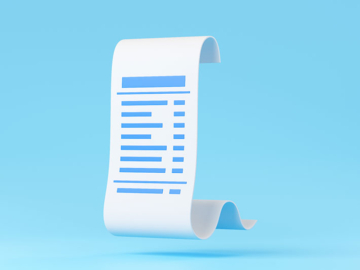The aging balance is an accounting balance that classifies outstanding receivables and payables by period. This enables you to identify the oldest unpaid invoices, which therefore require urgent treatment.
In practice, the longer it takes to settle an outstanding invoice, the more difficult it is to obtain payment. In addition to the difficulties of collection that an aged receivable can represent, it also has consequences for the company’s cash flow. The company can’t use the expected inflows to pay its expenses. This can lead to cash flow tensions, and even payment difficulties. The aging balance is therefore an essential tool for monitoring outstanding receivables and optimizing debt recovery where necessary. Here’s how it works.
What is an aging balance?
By definition, an aging balance is an accounting balance that lists a company’s receivables and payables by date of age, from the oldest to the most recent. To do this, it uses information from third-party accounts, i.e. customer and supplier accounts. Transactions are classified by due date, depending on whether they are more than 90 days overdue, more than 60 days overdue, more than 30 days overdue, less than 30 days overdue, etc.
The aging balance is an essential management tool, from both a commercial and a financial point of view.
 The aging balance makes it easy to identify the oldest receivables and payables, and therefore those to be dealt with first. As a result, you can carry out your customer reminders efficiently. You’ll know in real time which invoices are overdue, so you don’t have to follow up an overdue customer.You’ll also know how long the invoice has been overdue, enabling you to adapt your collection actions.
The aging balance makes it easy to identify the oldest receivables and payables, and therefore those to be dealt with first. As a result, you can carry out your customer reminders efficiently. You’ll know in real time which invoices are overdue, so you don’t have to follow up an overdue customer.You’ll also know how long the invoice has been overdue, enabling you to adapt your collection actions.The aging balance can also be used to highlight certain debt collection KPIs, such as the late payment rate and DSO. Analyzing this information can help you optimize your payment and collection policy.
In addition, the aging balance can be used to manage a company’s cash flow, and in particular its working capital requirements (WCR). It is a real aid in drawing up cash budgets. In fact, it enables you to identify pending incoming and outgoing flows and to take them into account in your calculations, in order to anticipate any cash flow shortfalls.
How do you calculate an aging balance?
To calculate the aging balance, you need to follow a number of steps. Namely:
- identify all outstanding trade receivables and supplier payables awaiting payment;
- classify these items by period of delay in descending order of age: over 90 days, 60-90 days, 30-60 days and under 30 days, for example;
- add up the amounts of all receivables on the one hand, and all supplier payables on the other.
 Classification by payment term, and more specifically by overdue period, enables you to prioritize the treatment of overdue invoices, and to adapt the actions to be taken. For example, for a receivable that is 30 days overdue, you will probably send a reminder, while for an invoice that is over 90 days overdue, you should send a formal notice if you have not already done so. What’s more, when it comes to organizing collection actions, the aged trial balance is a great help. In particular, you can combine similar actions to save time and facilitate follow-up.
Classification by payment term, and more specifically by overdue period, enables you to prioritize the treatment of overdue invoices, and to adapt the actions to be taken. For example, for a receivable that is 30 days overdue, you will probably send a reminder, while for an invoice that is over 90 days overdue, you should send a formal notice if you have not already done so. What’s more, when it comes to organizing collection actions, the aged trial balance is a great help. In particular, you can combine similar actions to save time and facilitate follow-up.How do you build an aging balance?
Before starting to draw up your company’s aging balance, please ensure that you have completed the following preliminary steps:
- accounting entry of all transactions;
- revision of accounts;
- accounting lettering;
- updating of payments.
Secondly, an accounting balance takes the form of a table. The same applies to the aging balance. To do this, you need to list the following information in the various columns:
- invoice number;
- invoice amount;
- invoice issue date;
- customer or supplier name;
- payment term;
- invoice amount already paid in the case of partial payment;
- number of days overdue.
You can use an Excel spreadsheet to create your aging balance. However, this can be time-consuming and error-prone. This is why the use of accounting software coupled with collection software appears to be the ideal solution. In this way, the aging balance is implemented as and when required, and information is updated in real time, without the need for manual input.
What are customer aging balance?
The aging balance is the aging balance that lists unpaid customer invoices in order of age.
In this way, the customer aged trial balance makes it easy to identify sales that are invoiced and due, but not yet collected. Above all, it facilitates debt collection actions, while preserving commercial relations with customers.
 In fact, by using the aging balance as the basis for your collection procedure, you can ensure that you take the right action depending on the customer’s profile and the length of time the debt has been outstanding. For example, you won’t risk offending a customer by reminding him when he paid the invoice a few days earlier. On the other hand, you can negotiate additional payment terms if necessary, or set up payment schedules. You should then update the customer aging balance, as this will influence the classification of the receivable.
In fact, by using the aging balance as the basis for your collection procedure, you can ensure that you take the right action depending on the customer’s profile and the length of time the debt has been outstanding. For example, you won’t risk offending a customer by reminding him when he paid the invoice a few days earlier. On the other hand, you can negotiate additional payment terms if necessary, or set up payment schedules. You should then update the customer aging balance, as this will influence the classification of the receivable.What’s more, you can adapt the payment policy applicable to a customer according to the profile that emerges from the aging balance (repetition, amount due, duration of overdue payments, number of reminders required, etc.). By setting clear payment terms, which will appear on all your customer’s contractual documents, you can easily refer to them to remain factual in your exchanges in the event of further late payment.
Last but not least, keeping track of customer aging balances enables you to monitor delays in collection, and thus anticipate shifts in incoming flows, for effective cash management.
What are suppliers aging balance?
 The aging balance is the accounting balance that lists all the company’s supplier debts by age. In other words, it lists all the invoices the company has to pay to its suppliers, according to their due dates and any late payments.
The aging balance is the accounting balance that lists all the company’s supplier debts by age. In other words, it lists all the invoices the company has to pay to its suppliers, according to their due dates and any late payments.As a result, the aging balance ensures that the company is up to date with its supplier payments, i.e. that it complies with the payment deadlines negotiated with them.
Keeping a close eye on the supplier aging balance enables you to anticipate cash outflows for the payment of expenses. It’s also an excellent way of maintaining good relations with suppliers, avoiding late payments and, if necessary, negotiating longer payment terms.
Conclusion
The aging balance is a key tool for tracking receivables and optimizing corporate financial management. However, to make the most of this tool, you need to adapt a rigorous methodology. This applies both to the calculation of the aged trial balance and to its follow-up. That’s why relying on a new, simple and reliable tool, such as collection software linked to your accounting software, makes ageing schedules easier to use and maximizes their effectiveness.